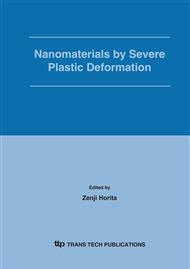[1]
E.O. Hall: The deformation and ageing of mild steel. Proc. R. Soc. B64, 747 (1951).
Google Scholar
[2]
N.J. Petch: The cleavage strength of polycrystals. J. Iron Steel Inst. 174, 25 (1953).
Google Scholar
[3]
J.C.M. Li: Petch relation and grain boundary sources. Trans. AIME 227, 239 (1963).
Google Scholar
[4]
M.F. Ashby: The deformation of plastically non-homogeneous materials. Phil. Mag. 21, 399 (1970).
Google Scholar
[5]
J.W. Morris, Jr.: in Proc. Int. Symposium on Ultrafine Grained Steels, edited by S. Takaki and T. Maki (Iron and Steel Inst., Tokyo, Japan, 2001), p.34.
Google Scholar
[6]
J.J. Hauser, and B. Chalmers: The plastic deformation of bicrystals of f. c. c. metals. Acta Fig. 4 TEM micrographs of the Fe-C martensite after nanoindentation, with outlines of the original positions before indentation. (a) low-angle grain boundary and (b) high-angle grain boundary. (a) (b) Matell. 9, 802 (1961).
Google Scholar
[7]
W.E. Carrington, and D. McLean: Slip nuclei in silicon-iron. Acta Matell. 13, 493 (1965).
DOI: 10.1016/0001-6160(65)90099-4
Google Scholar
[8]
Z. Shen, R.H. Wagoner, and W.A.T. Clark: Dislocation pile-up and grain boundary interactions in 304 stainless steel. Acta Metall. 36, 3231 (1988).
DOI: 10.1016/0036-9748(86)90467-9
Google Scholar
[9]
K.J. Kurzydlowski, R.A. Varin and W. Zielinski: In situ investigation of the early stages of plastic deformation in an austenitic stainless steel. Acta Metall 32, 71 (1984).
DOI: 10.1016/0001-6160(84)90203-7
Google Scholar
[10]
T.C. Lee, I.M. Robertson, and H.K. Birnbaum: An insitu transmission electron-microscope deformation study of the slip transfer mechanisms in metals. Met. Trans. 21A, 2437 (1990).
DOI: 10.1007/bf02646988
Google Scholar
[11]
T. Maki, K. Tsuzaki, and I. Tamura: The morphology of microstructure composed of lath martensites in steels. Trans. ISIJ, 20 207 (1980).
DOI: 10.2355/isijinternational1966.20.207
Google Scholar
[12]
H.J. Kim, Y.H. Kim, and J.W. Morris, Jr.: Thermal mechanisms of grain and packet refinement in a lath martensitic steel. ISIJ Int., 38, 1277 (1998).
DOI: 10.2355/isijinternational.38.1277
Google Scholar
[13]
T. Ohmura, K. Tsuzaki, and S. Matsuoka: Nanohardness measurement of high-purity Fe-C martensite. Scripta Mater. 45, 889 (2001).
DOI: 10.1016/s1359-6462(01)01121-6
Google Scholar
[14]
T. Ohmura, K. Tsuzaki, and S. Matsuoka: Evaluation of the matrix strength of Fe-0. 4 wt% C tempered martensite using nanoindentation techniques. Phil. Mag. A 82, 1903 (2002).
DOI: 10.1080/01418610210135070
Google Scholar
[15]
T. Ohmura, T. Hara, and K. Tsuzaki: Relationship between nanohardness and microstructures in high-purity Fe-C as-quenched and quench-tempered martensite. J. Mater. Res. 18, 1465 (2003).
DOI: 10.1557/jmr.2003.0201
Google Scholar
[16]
T. Ohmura, T. Hara, and K. Tsuzaki: Evaluation of temper softening behavior of Fe-C binary martensitic steels by nanoindentaiton. Scripta Mater. 49, 1157 (2003).
DOI: 10.1016/j.scriptamat.2003.08.025
Google Scholar
[17]
J.W. Morris, Jr., C.S. Lee, and Z. Guo: The nature and consequences of coherent transformations in steel, ISIJ Int., 43, 410 (2003).
DOI: 10.2355/isijinternational.43.410
Google Scholar
[18]
Z. Guo, and J.W. Morris, Jr.: The effective grain size of martensitic steel. (submitted).
Google Scholar
[19]
A.M. Minor, E.A. Stach, and J.W. Morris, Jr.: Quantitative in situ nanoindentation in an electron microscope. Appl. Phys. Lett., 79, 1625 (2001).
DOI: 10.1063/1.1400768
Google Scholar
[20]
E.A. Stach, T. Freeman, A.M. Minor, D.K. Owen, J. Cumings, M.A. Wall, T. Chraska, R. Hull, J.W. Morris, Jr., A. Zettl, and U. Dahmen: Development of a nanoindenter for in situ transmission electron microscopy. Microscopy and Microanalysis, 7, 507 (2001).
DOI: 10.1007/s10005-001-0012-4
Google Scholar
[21]
A.R. Marder and G. Krauss: The morphology of martensite in iron-carbon alloys. Transactions of the ASM, 60, 651 (1967).
Google Scholar
[22]
J.M. Marder and A.R. Marder: The morphology of iron-nickel massive martensite. Transactions of the ASM, 62, 1 (1969).
Google Scholar
[23]
S. Morito, H. Tanaka, R. Konishi, T. Furuhara and T. Maki: The morphology and crystallography of lath martensite in Fe-C alloys. Acta Mater., 51, 1789 (2003).
DOI: 10.1016/s1359-6454(02)00577-3
Google Scholar
[24]
Z. Guo: PhD Thesis, Dept. Materials Science, Univ. of California, Berkeley (2001).
Google Scholar


